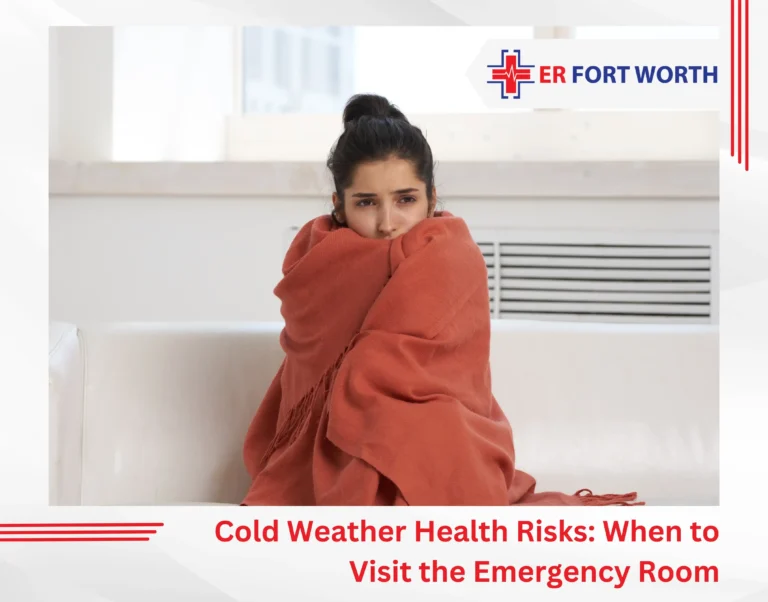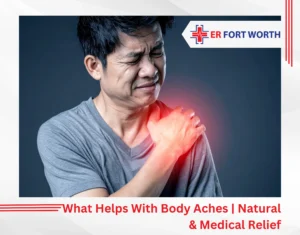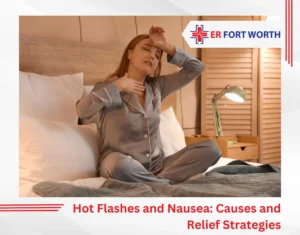When exposed to cold, your body loses heat faster than it can generate it. If this goes on too long, the body burns its energy, and the temperature drops. If your core temperature falls below 95°F, it can lead to hypothermia, frostbite, and other serious issues. Cold weather is also the perfect breeding ground for viruses.
Let’s explore common cold weather health risks that require emergency care and how ER Fort Worth provides specialized treatment. Get the information so you can get back to enjoying your warm drinks and cozy winter nights.
Who’s Most at Risk of Cold Weather Health Risks?
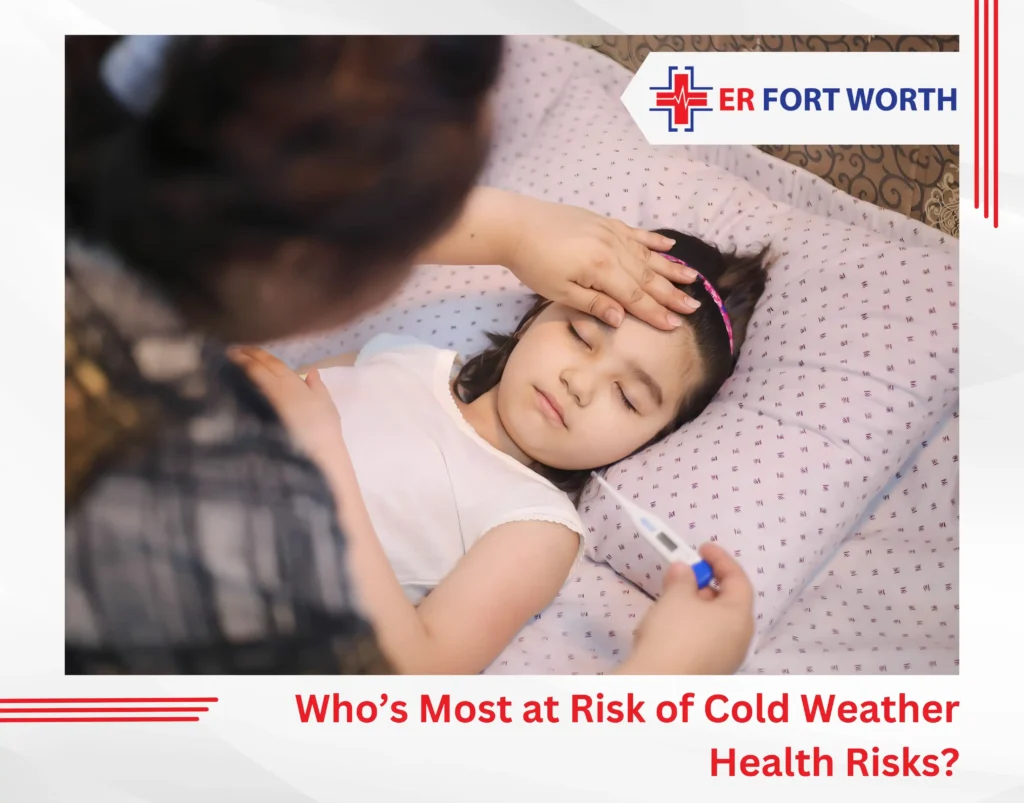
Certain groups face higher risks during cold weather:
- Seniors: Less efficient body temperature regulation and slower response to cold
- Young children: Still-developing temperature regulation systems
- Low income individuals: Limited access to adequate heating and winter protection
- Those with chronic conditions: Including heart disease, respiratory issues, and diabetes
- Individuals with disabilities: May have difficulty responding to cold stress or seeking warmth
- Pregnant women: Changes in circulation affect temperature regulation
- People with mental health conditions: May have reduced awareness of cold exposure risks
7 Common Cold Weather Health Risks
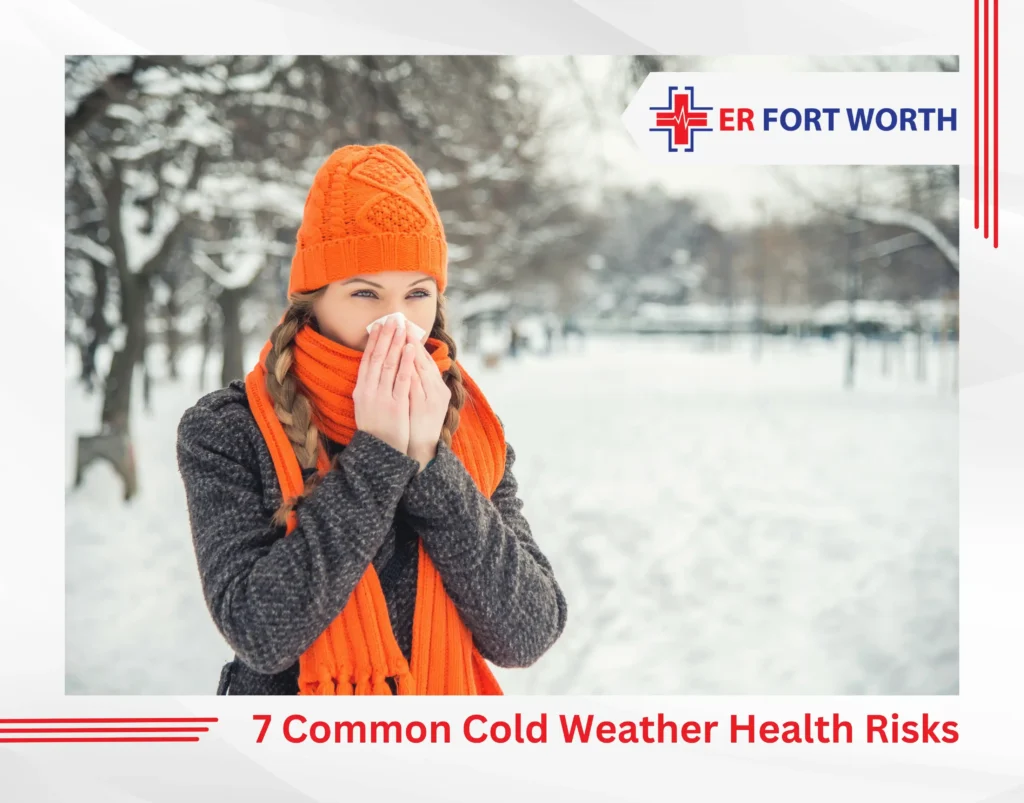
Here are seven common winter health issues:
1. Hypothermia
Your normal body temperature is about 98.6°F (37°C). In hypothermia, it drops below 95°F (35°C). Signs include uncontrollable shivering, confusion, slurred speech, a weak pulse, drowsiness, and unconsciousness in severe cases.
While hypothermia is linked with outdoor exposure, it can also happen indoors if the house isn’t heated enough. This is a life-threatening condition that needs immediate medical help.
2. Frostbite
In freezing temperatures, your body reduces blood flow to your hands and feet to keep your vital organs warm. When this happens, the tissue in your hands and feet can freeze into ice crystals. These crystals damage cells and tissues, causing frostbite.
Temperature below -0.55C imposes the risk of frostbite. Fingers, toes, nose, ears, and cheeks are the most common areas affected. They become hard, white, gray, or black, and will feel cold, numb, or may be painful.
3. Slips and Falls
Snow and ice make everything wet, which can cause slips and falls. Even more dangerous is black ice—it forms on roads and is nearly invisible, especially at night.
4. Heart Attacks
Cold weather narrows your blood vessels and thickens blood, so the heart has to work harder. This extra strain on your heart raises the risk of a heart attack. Simple tasks like shoveling snow or walking against a biting cold wind can trigger a heart attack in those with prior heart problems.
5. Winter Viruses
Cold, dry air makes it easier for germs in respiratory droplets to spread. The indoor holiday gatherings create the perfect environment for germs to hop from person to person. This is the reason colds, flu, and other respiratory illnesses are more common in colder months. Common winter viruses include:
- Common Cold (rhinovirus)
- Flu (Influenza)
- COVID-19
- RSV (Respiratory Syncytial Virus)
- Chest Cold (Bronchitis)
- Pneumonia
- Sinus Infection
- Strep Throat
- Stomach Bug (Norovirus)
6. Seasonal Affective Disorder (SAD)
The reduced sunlight duration during winter interferes with your body’s internal clock. Your serotonin levels—the brain chemical that helps regulate your mood—drop, which results in this condition. SAD is a more serious form of depression than “winter blues.”
7. Carbon Monoxide Poisoning
Carbon monoxide poisoning is common in the winter season. Usually, people are packed in areas without proper air flow or ventilation to prevent cold. Heat sources like furnaces, and gas stoves cause CO to build up. This is a deadly condition. If you suspect CO poisoning, leave the area immediately, get fresh air, and reach ER fort Worth.
When to Visit the ER Fort Worth for Cold Weather Health Issues
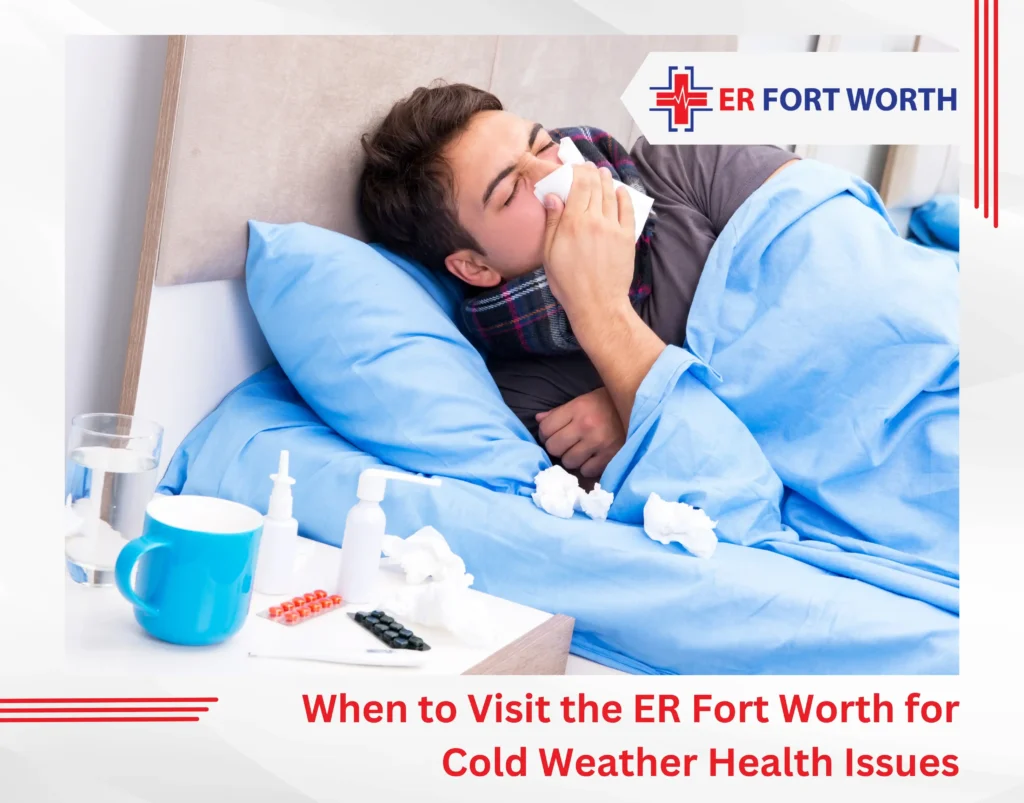
Sometimes, cold symptoms cross the line into serious territory. Head to the ER if you’re experiencing:
- Shortness of breath, wheezing, or chest tightness
- For adults, a fever over 103°F or lasting more than three days
- Persistent or worsening throat pain with difficulty swallowing
- Unable to keep fluids down due to nausea or vomiting
- A cold lasting more than 10 days, or symptoms that keep coming back
- If you are someone with chronic illness, weak immune system, or conditions like COPD, asthma, or diabetes
For hypothermia and frostbite, the following symptoms need an immediate trip to the ER:
- White, grayish, yellow, or black blisters on the skin
- Failure to rewarm the affected areas
- Can’t regain normal sensation
- Intense pain
- Slurred speech
- Drowsiness
- Trouble walking
How ER Fort Worth Treat Cold Weather Health Risks
ER of Fort Worth provides essential first aid and ongoing care for cold-related health issues. Here’s a brief overview:
Hypothermia & Frostbite Treatment
- Rewarming techniques: This includes using heated blankets, or giving warm IV fluids. A hemodialysis machine warms the blood and recirculates it in the body.
- Airway rewarming: Heated air can be administered through a high-flow nasal cannula.
- Wound care: Blisters or open wounds are treated to prevent infection.
Injury Management
If there are any wounds after slips and falls we treat them. Then our imaging services like X-rays and CT scans check for bone fractures. Mild bone fractures are treated with splints, casts, or braces. The more complex fractures are treated with surgery. Meanwhile, we give pain relief medications to ease you.
Respiratory Problem Management
If a patient comes with respiratory problems or viral infections here’s what we do:
- Oxygen therapy: Humidified oxygen or supplemental oxygen through a mask or nasal prongs restore oxygen levels in the blood.
- Nebulizer treatments: For issues such as asthma attacks, medications are directly delivered to the lungs to ease breathing.
- Infection management: Antibiotics, antiviral medications, or intravenous immunoglobulin treat underlying causes like pneumonia or flu.
Heart Attack Response
The cold weather increases heart attack risks. So our emergency room is prepared with EKG Monitoring to diagnose heart attacks. Blood thinners, pain relievers, and other medications restore heart function.
Mental Therapy
Our mental health professionals at the ER of Fort Worth treat seasonal affective disorder (SAD) with light therapy, cognitive behavioral therapy (CBT), and antidepressants.
Final Thoughts
Being aware of winter health dangers can help you enjoy the good things winter offers. Dress warmly, stay hydrated, and check on loved ones, especially older adults. Remember, our Fort Worth ER is open 24/7. Reach out to us immediately if you experience any symptoms. Stay safe with us this winter.
FAQs
1. Why are older people more at risk of cold weather health risks?
Older people have a decreased blood flow and slower metabolism so it’s harder for them to maintain a normal body temperature. Muscle helps generate body heat. But as we age, we lose muscle, so staying warm gets even tougher. That’s why older folks need extra care in the winter to avoid problems like heart attacks, strokes, pneumonia, depression, and sore joints.
2. How to stay safe from cold weather health issues?
Dress in layers when you go outside. If you’re using a space heater or fireplace, make sure there’s proper airflow. Don’t overdo it in cold weather, especially if you have heart problems (but staying active is still important). Keep walkways free of ice and wear shoes with good grip. Finally, get your flu shot and wash your hands often to avoid germs.

